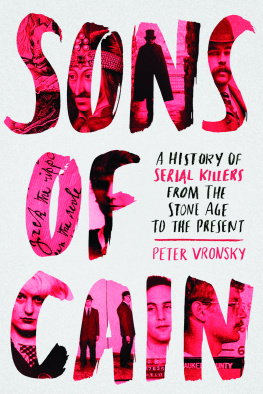

Introduction
God will forgive you, the State, not was the answer to William Heirens request for probation. Heirens was about to turn 80, 61 of which he had spent in jail for being found guilty of three murders in 1946. He eventually died in jail on March 5, 2012.
66 years earlier, when his perverse murders became public and Heirens was arrested, a 9-year-old boy named Robert Ressler became interested in the case. Although a boy his age wasnt capable of investigating the case in depth, this was the beginning of a life devoted to criminological study.
After serving in the army for 10 years, Ressler worked for the FBI for another 20 years. He was the pioneer of the design of psychological profiles as a system of identification and capture of murderers. In the 1970s, Ressler coined the term serial killer.
In order to develop the theories that would enable him to create the suspects profiles, the criminologist interviewed hundreds of murderers, some of them famous: Ted Bundy, Jeffrey Dahmer, John Wayne Gacy, David Berkowitz, Edmund Kemper and Charles Manson.
In the 1990s, retired from the FBI, he helped the police of several countries solve critical cases. He even collaborated in novels and films about serial killers, such as The Silence of the Lambs and American Psychopath . However, Ressler never agreed with the model of killers presented by Hollywood.
His contribution to crime prevention is embodied in three books, the last of which, Serial Killers, explores this topic that generally gives rise to sensationalism, with a brilliant sobriety.
Another interesting work was conceived by neurologist Jonathan Pincus under the title Basic Instincts. In the book, he thoroughly analyzes the life of numerous serial killers and other violent criminals. Other valuable books on this issue are Monsters Among Us, by Carlos Manuel Cruz Mesa and Serial Killers: The Growing Menace, by Joel Norris.
The opinions expressed in these books do not coincide completely, but some hypotheses can be summarized from the many contact points and the statements of other expert criminologists:
The sexual factor is essential for interpreting these types of crimes. Recently, it is believed that 90% of serial killers are driven by a motive of sexual nature, and only 10% are driven by other types of motivations.
Penetration is not necessary for considering a serial killers impulses to be sexual. Serial killers minds associate sex with death. They are full of fantasies which increase their sexual desire, but its completion is the victims death, not necessarily the sexual act.
Serial killers dissociate the concept of sexuality, which prevents them from maintaining stable relationships. Some of them are impotent in practice, although they may have an erection when they kill.
Many of them return to the crime scene -- not for regret or for cleaning the trail -- but in order to get excited while evoking the moment of the crime.
Trophies -- objects belonging to the victims, which are kept by murderers -- fulfill the same function. They may be rings, necklaces or handkerchiefs, which they sometimes give to other people, enjoying the real meaning of such objects.
Social isolation does not necessarily boost the emergence of serial killers. Some of the most brutal ones have lived seemingly normal lives while fulfilling their fantasies in the dark.
These people have a ritualized behavior which remains unchanged during their sequences of crimes. They will only stop killing if they are captured, get sick, or die.
The killer instinct is not genetic. Nobody is born a serial killer. The essential period in the formation of the mind is during the first six years of life. In that period, personality is defined, and the ability to relate to other people, distinguish goodness from evil and limit desires is conceived.
A great number of serial killers were raised in a dysfunctional family where the parents mistreated them, were indifferent to them, or where one of them was missing. There are many cases of unwanted children, or mothers frustrated by not having had a girl, who consequently dress their sons in female clothes. In many cases, parents blame their deceptions and failures on these sons.
Ressler considers it possible to reverse the killer instinct through some figure of authority up until approximately 12 years of age, whether it is the parents, an older sibling, or a respected friend. However, being born in a dysfunctional family or being unwanted by parents does not automatically trigger a future serial killer.

Some Statistics
There are a series of factors that converge in most serial killers. Historians have said that if not all nationalisms are fascist, then all fascists are nationalist. For example, serial killers are usually white males 20 to 40 years old. But that does not mean that, although rare, some killers are younger or even female.
Some recurrent factors shared by serial killers have been detected: causing small incidents during their youth, violence towards animals and experiencing nocturnal enuresis (involuntary wetting during sleep), up to an advanced age.
A statistical analysis on the presence of serial killers in different countries concludes that more than 70% of serial killers are located in the United States.
The state of California has the highest rate of serial killers in the history of the country. Following it are Texas, New York, Illinois and Florida.
On a global scale, the countries with the greatest number of cases behind the United States are: England, Germany and France.
90% of serial killers around the world are male, 65% of the victims are female and 89% of the total number of victims (both male and female) are Caucasian.

Organized or Disorganized, Always Brutal
In the book Serial Killers, Ressler makes a distinction between organized killers (psychopaths) and disorganized ones (those suffering from another mental illness). This distinction takes into account the crime scene and the type of victims chosen.
Organized Killers
They plan their crimes. In general they choose low risk victims (prostitutes, homeless people and hitchhikers). They use their own vehicle, whether to go to the crime place or to discard the body. They are not too bloody at the time of killing and have the required equipment to perform the attack.
In fact, Ressler says they carry a rape kit. In his own words: They choose unknown people and capture them following some criteria. They look for someone who fits the type of victim they have in mind in terms of age, appearance, profession and lifestyle. Many of them, when they go hunting carry the rape kit in order to avoid problems when subduing the victim and leaving them submissive, an essential element of their fantasy.
Although serial murderers are usually lonely and introverted men, organized killers are those who can best combine their criminal side with a seemingly normal life.
Disorganized Killers
These criminals are characterized by unlimited brutality, their lack of control and improvisation. They walk or take the bus to the murder place, choose their victims at random, without thinking about the danger involved for them. They do not care about the traces that may remain at the scene of the crime and are extremely brutal, often practicing mutilation and cannibalism.
















